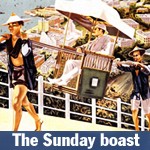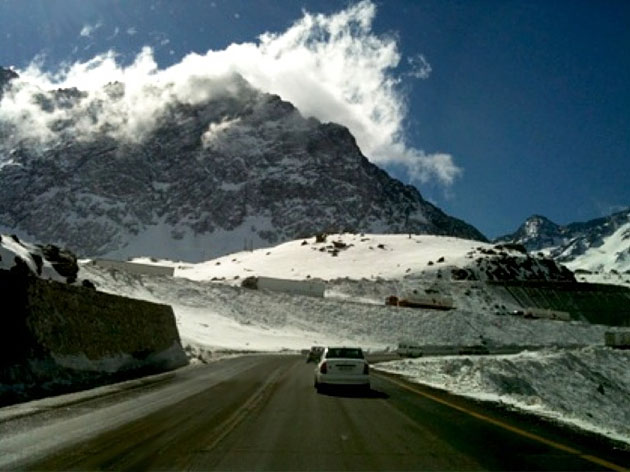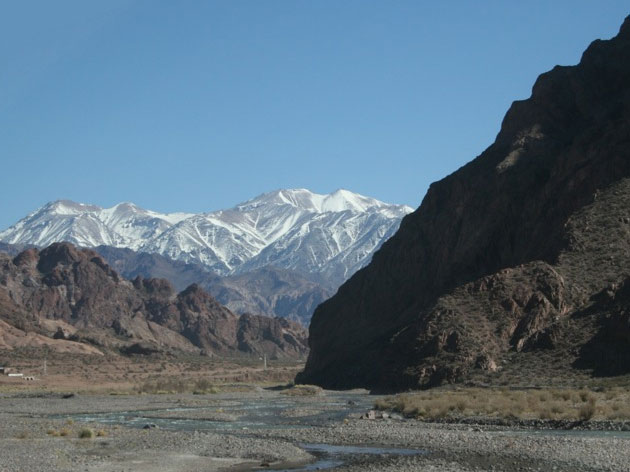
Lilani Goonesena writes: The drive from Chile’s capital of Santiago to the wine country of Mendoza, Argentina, is truly spectacular. The narrow, two-lane road labours through the winding Andes mountain range, passing ski fields and culminating in 27 steep switchbacks snaking up to the border.
Across the border, the road gently slopes down, skirting the magnificent Aconcagua, the highest mountain in the Americas at just under 7,000m and crosses the desert of the Cuyo region. Canyons, glacial lakes and sparse vegetation sit against the backdrop of distant mountains and a skinny Rio Mendoza weaves alongside all the way into the city.
Hundreds of trucks travel this road every day — there’s no railway and flights aren’t cheap — making it an important commercial transport route. Though snowstorms can block the pass for days during the winter months, the border is officially open year round.

Buses and cars also carry tourists and locals back and forth and it’s easy for traffic to build up, especially on weekends and holidays. We found this out the hard way — on our return to Chile, we sat in our car barely moving for five hours, staring longingly at the border crossing only 200m ahead.
Cuyo is also the “wine cellar” of Argentina; its province of Mendoza produces 80% of the country’s wine industry. Argentinians are big wine drinkers. They rank fifth in the world for production and until about 20 years ago, drank 90% of it themselves. Then they cottoned onto the lucrative export market and are now one of the world’s top exporters. If you’ve tried an Argentinian wine, chances are it was their signature grape, Malbec.
The Malbec grape was introduced from France in the mid-1800s where it was considered a minor varietal of the Bordeaux blend. Mendoza’s dry climate suited it perfectly however and currently is the world’s biggest producer of Malbec. Italian immigrants in later decades brought with them other European varietals and today, Argentina has a well-rounded and burgeoning wine industry.
For a wine enthusiast, Mendoza is definitely a place worth visiting. That it means a road trip across one of the world’s great mountain ranges to get there is just a bonus.

Which is how we found ourselves on a clear, cold, spring day looking out onto fresh snow-capped mountains on the windy road up to the border. Uncharacteristically, it had rained in Santiago the previous night and we worried that the border would be closed. In typical Latino style, information on both the Chilean and Argentine border websites was not forthcoming, so after a fruitless hour of searching, we just said what the hell and went.
It took three hours to reach the border, climbing higher and higher and passing very few other vehicles along the way. Well, it was a Sunday morning; everyone must have been in bed or at church. The roads were clear as a bell, if anything the rain had left everything clean and crisp.
Finally, we arrived at the Argentine border — a giant hangar with a few laneways and lots of relaxed-looking officials, bundled up in coats. It was pretty quiet with only a couple of other cars and a tourist bus. I hopped out to stretch my legs and immediately reached for my gloves and hat–– springtime weather at 3,500 metres is, not surprisingly, a little chilly.
Knowing the Latino love of bureaucracy and paperwork, we had come armed with every possible document relating to the car and ourselves but the Argentine customs just gave us a cursory glance. The only query they had was about the nespresso machine my partner insisted on bringing — understandable perhaps when the local blend is Nescafe instant.

Then we were in Argentina and the snow morphed into red rock desert, drier and more barren than I’d imagined. A disused, single-lane railway ran alongside for almost 250km from the border. British engineers built it in the late 1800s and its empty tracks led us across the desert to Mendoza.
I know wine grapes thrive in a dry climate but I was frankly amazed that anything grew in such a barren environment. The empty desert finally gave way to signs of life with a lot more cars on the road, most of them ancient relics from a bygone era. We arrived into Mendoza in the late afternoon, the streets quiet and sleepy with a real “country” feel to it.
It is a small city or a large town, the main part of which is a neat grid of wide, tree-lined streets, and cornered by four plazas. Makeshift Sunday markets drew tourists and locals alike, families played on the grass and stray dogs snoozed in the sun.
Our accommodation was right in this part of town, an apartment near Plaza Independencia. We parked on the street, carted numerous bags upstairs and then set off to find some takeaway for dinner. Hot empanadas straight out of the oven and washed down with our first glass of Argentinian Malbec really made us feel we were on holiday.
Lilani is an Australian living in Santiago, Chile, with her partner and toddler daughter. She also blogs at three amigos in Chile — where an edited version of this post first appeared.







Crikey is committed to hosting lively discussions. Help us keep the conversation useful, interesting and welcoming. We aim to publish comments quickly in the interest of promoting robust conversation, but we’re a small team and we deploy filters to protect against legal risk. Occasionally your comment may be held up while we review, but we’re working as fast as we can to keep the conversation rolling.
The Crikey comment section is members-only content. Please subscribe to leave a comment.
The Crikey comment section is members-only content. Please login to leave a comment.